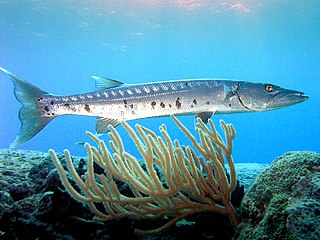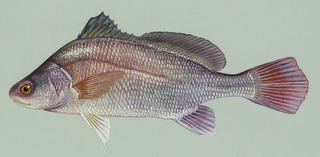
Tetraodontiformes, also known as the Plectognathi, is an order of ray-finned fishes which includes the pufferfishes and related taxa. This order has been classified as a suborder of the order Perciformes, although recent studies have found that it, as the Tetraodontoidei, is a sister taxon to the anglerfish order Lophiiformes, called Lophiodei, and have placed both taxa within the Acanthuriformes. The Tetraodontiformes are represented by 10 extant families and at around 430 species overall. The majority of the species within this order are marine but a few may be found in freshwater. They are found throughout the world.

The quillback, also known as the quillback sucker, is a type of freshwater fish of the sucker family widely distributed throughout North America. It is deeper-bodied than most suckers, leading to a fuller-bodied appearance. However, the quillback is not a carp. Quillback are catostomids, and like all catstomids, they do not have barbels around the mouth. The quillback is long-lived, with age up to 30 years, 44 years, 49 years, and 52 years documented across different studies throughout North America.
Ophidiiformes is an order of ray-finned fish that includes the cusk-eels, pearlfishes, viviparous brotulas, and others. Members of this order have small heads and long slender bodies. They have either smooth scales or no scales, a long dorsal fin and an anal fin that typically runs into the caudal fin. They mostly come from the tropics and subtropics, and live in both freshwater and marine habitats, including abyssal depths. They have adopted a range of feeding methods and lifestyles, including parasitism. The majority are egg-laying, but some are viviparous.

Gars are an ancient group of ray-finned fish in the family Lepisosteidae. They comprise seven living species of fish in two genera that inhabit fresh, brackish, and occasionally marine waters of eastern North America, Central America and Cuba in the Caribbean, though extinct members of the family were more widespread. They are the only surviving members of the Ginglymodi, a clade of fish which first appeared during the Triassic, over 240 million years ago, and are one of only two surviving groups of holosteian fish, alongside the bowfins, which have a similar distribution.

A barracuda is a large, predatory, ray-finned fish known for its fearsome appearance and ferocious behaviour. The barracuda is a saltwater fish of the genus Sphyraena, the only genus in the family Sphyraenidae, which was named by Constantine Samuel Rafinesque in 1815. It is found in tropical and subtropical oceans worldwide ranging from the eastern border of the Atlantic Ocean to the Red Sea, on its western border the Caribbean Sea, and in tropical areas of the Pacific Ocean. Barracudas reside near the top of the water and near coral reefs and sea grasses. Barracudas are targeted by sport-fishing enthusiasts.

The Moronidae is a family of percomorph fishes, commonly called the temperate basses, in the order Moroniformes. These fishes are found in the freshwaters of North America and the coastal waters of the North Atlantic.

Bowfishing is a fishing technique that uses specialized archery equipment to impale and retrieve fish. A bowfisher will use a bow or crossbow to shoot fish through the water surface with a barbed arrow tethered to a line, and then manually retrieve the line and arrow back, in modern times usually with a reel mounted on the bow. Unlike other popular forms of fishing where baiting and exploiting the fish's instinctual behaviors are important, bowfishing is similar to spearfishing and relies purely on the fisherman's own visual perception and marksmanship, and usually do not involve using other tools such as hand net.

The freshwater drum, Aplodinotus grunniens, is a fish endemic to North and Central America. It is the only species in the genus Aplodinotus, and is a member of the family Sciaenidae. It is the only North American member of the group that inhabits freshwater for its entire life. Its generic name, Aplodinotus, comes from Greek meaning "single back", and the specific epithet, grunniens, comes from a Latin word meaning "grunting". It is given to it because of the grunting noise that mature males make. This noise comes from a special set of muscles within the body cavity that vibrate against the swim bladder. The purpose of the grunting is unknown, but due to it being present in only mature males and during the spawning season, it is assumed to be linked to spawning.

The shovelnose sturgeon is the smallest species of freshwater sturgeon native to North America. It is often called hackleback, sand sturgeon, or switchtail. Switchtail refers to the long filament found on the upper lobe of the caudal fin. Shovelnose sturgeon are the most abundant sturgeon found in the Missouri River and Mississippi River systems, and were formerly a commercially fished sturgeon in the United States of America. In 2010, they were listed as threatened under the U.S. Endangered Species Act due to their resemblance to the endangered pallid sturgeon, with which shovelnose sturgeon are sympatric.

Unionida is a monophyletic order of freshwater mussels, aquatic bivalve molluscs. The order includes most of the larger freshwater mussels, including the freshwater pearl mussels. The most common families are the Unionidae and the Margaritiferidae. All have in common a larval stage that is temporarily parasitic on fish, nacreous shells, high in organic matter, that may crack upon drying out, and siphons too short to permit the animal to live deeply buried in sediment.

Moxostoma, the redhorses or jumprocks, is a genus of North American ray-finned fish in the family Catostomidae. Redhorses are variable in size, geographic location, and other ecological traits such as spawning substrate. Several redhorses are long-lived, much like many other catostomid species. The silver redhorse is the longest-lived redhorse known by nearly a decade, with ages exceeding 40 years. Redhorses are broadly of conservation concern, as these long-lived species are highly intolerant to environmental pollution, habitat fragmentation, and are currently subject to unregulated 21st century sport bowfishing which is removing and wantonly wasting several of these species by the ton.

Eels are ray-finned fish belonging to the order Anguilliformes, which consists of eight suborders, 20 families, 164 genera, and about 1000 species. Eels undergo considerable development from the early larval stage to the eventual adult stage and are usually predators.

The Catostomidae are the suckers of the order Cypriniformes, with about 78 species in this family of freshwater fishes. The Catostomidae are almost exclusively native to North America. The only exceptions are Catostomus catostomus, found in both North America and Russia, and Myxocyprinus asiaticus found only in China. In the Ozarks they are a common food fish and a festival is held each year to celebrate them. The bigmouth buffalo, Ictiobus cyprinellus, can reach an age up to 127 years, making it the oldest known freshwater teleost by more than 50 years.

Leuciscinae is a subfamily of the freshwater fish family Cyprinidae, which contains the true minnows.

Ictiobus, also known as buffalofishes, buffalofish or simply buffalo, is a genus of freshwater fish native to North America, specifically the United States, Canada, Mexico, and Guatemala. They are the largest and longest-lived of the North American suckers, reaching up to 1.23 m (4.0 ft) in length and more than 100 years of age for three of the five species. At up to 127 years for bigmouth buffalo, they are the longest-lived freshwater teleost, which is a group of more than 12,000 species. Bigmouth buffalo, black buffalo and smallmouth buffalo are found in the United States or Canada. Little is known about the two other buffalofish species: the fleshylip buffalo found in Mexico, or the usumacinta buffalo found in Mexico and Guatemala. Buffalofish are not carp, nor is any other catostomid; they belong to different scientific families having evolved on separate continents. Buffalofish live in most types of freshwater bodies where panfish are found, such as ponds, creeks, rivers, and lakes. Ictiobus were caught by the Lewis and Clark Expedition.

The river carpsucker is a freshwater fish belonging to the Catostomidae that is native to the inland United States and northern Mexico. This species has a slightly arched back and is somewhat stout and compressed. While the fins are usually opaque, in older fish they may be dark yellow. It is distributed along the Mississippi River basin from Pennsylvania to Montana. The river carpsucker, like most suckers, is a bottom feeder and obtains its nutrients from algae, microcrustaceans, and other various tiny planktonic plants and animals found in silty substrates. Like its congener, the quillback, the river carpsucker is long-lived, with a known maximum lifespan of 40 years in Colorado, and 47 years in Minnesota. It begins to reproduce typically in late spring, and the female usually releases more than 100,000 eggs. There is no parental care provided.
The highfin carpsucker is a freshwater fish found in the southeastern and midwestern United States. Its usual habitat is medium to large-size rivers where it is mostly found 1 to 3 metres beneath the surface. It is a silvery fish with a prominent dorsal fin, which grows to an average length of 26.5 centimetres (10 in). It reaches sexual maturity at the age of three and females have 41,644 to 62,355 ova each. This fish forages on sandy or gravelly bottoms for such small invertebrates as crustaceans, protozoa and mollusks as well as filamentous algae. Young fish are preyed on by northern pike, muskellunge, walleye and largemouth bass and larger fish are caught by recreational fishermen. The highfin carpsucker competes with catfish and does not thrive in rivers with high levels of siltation.

The bluntnose minnow is a species of temperate freshwater fish belonging to the genus Pimephales of the cyprinid family. Its natural geographic range extends from the Great Lakes south along the Mississippi River basin to Louisiana, and east across the Midwestern United States to New York State. The bluntnose is very ubiquitous, and may be the most common freshwater fish in the Eastern U.S.
Delane C. Kritsky is an American parasitologist who specialised on the Monogenea, a class of parasitic flatworms which are important ectoparasites of fishes. His research was mainly in the fields of taxonomy, faunistics, and phylogeny of the Monogenea.

Ambleminae is a subfamily of freshwater mussel in the family Unionidae. They are found throughout much of eastern North America south to Central America, although fossils are also known from Siberia. Some species have also been introduced to East Asia. They are the most speciose radiation of the Unionidae, with more than 300 species.

















